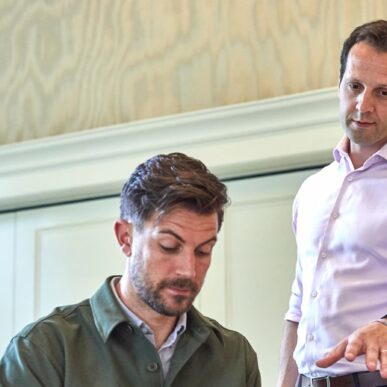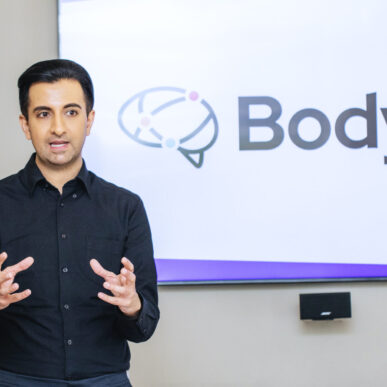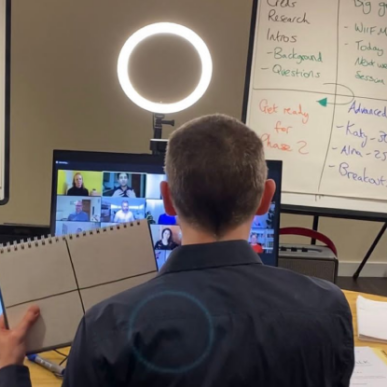“As a leader, your choice of body language and your voice can significantly impact how confident and authoritative you appear. “
The Communication Habits Of Great Leaders
What is it that makes some people great leaders?
It’s easy to think that there are people who are born leaders. While it may be true that some people gravitate naturally to positions of leadership, research shows that only around 30% of leadership is genetic, whilst the other 70% is about life experience and building up skills.
To put it simply: the communication habits adopted by great leaders can be learned by anyone to help to improve your authority.
So when it comes to communication, what is it that makes great leaders great?
They look and sound like leaders
One thing that sets great leaders apart is how engaging and commanding they are when they stand up and speak.
Whether you’re a president addressing a whole nation or a manager speaking to a small team, your choice of body language and use of your voice can have a significant impact on how confident and authoritative you appear.
Stand like a leader
The most effective way to stand when giving a speech or presentation is with your feet shoulder-width apart. Not only will it give you a solid foundation to help you avoid unnecessary shuffling or toe-tapping, but it will also show your audience that you are confident and in control.
This powerful position has been scientifically proven to be the most effective way of standing: it establishes you as the pack leader in the eyes of your audience.
It’s easy to find examples of this too – look at some of the most respected leaders in recent history: from Queen Elizabeth II to Barack Obama; a confident stance helps to solidify your authority and make you seem important. From film characters to politicians, you’ll find the greatest leaders standing like this; an outward display of their confidence.
Sound like a leader
How often do you think about your voice when planning a speech or presentation? The chances are that you don’t do it very often.
But great leaders know that by controlling their voice and making conscious choices about their delivery, they can control how their audience feels.
If you want to motivate your audience to get behind you, you can speak at a faster pace and with a slightly higher pitch. If you sound enthusiastic and energised, those feelings will transfer to your audience through your words.
On the other hand, if you’ve got a serious message to deliver, great leaders will lower their pitch, talk at the deeper end of their vocal range, and slow down their speech. If you do this, you’ll become more commanding and authoritative.
Pausing before or after key points can also help to come across well as a leader. Adding a well-chosen pause not only gives your audience time to focus on your message, but it also shows that you’re in control of what you’re saying; that it’s deliberate, considered and planned.
Winston Churchill was one of the greatest speakers of the 20th Century. His speeches, some of which you can listen to here, were carefully prepared with changes of pace, dramatic pauses and rhetorical flourishes. His most famous ‘Battle of Britain’ speech was so convincing that the next opinion poll gave him an 88% approval rating.
So for your next speech or presentation, take the time to plan out how you want your body language and voice to reflect the words you will be delivering.
They use persuasive storytelling
Great leaders don’t just bombard us with cold facts and figures: they tell compelling stories that are carefully structured in order to persuade us to follow them. This is a pattern repeated throughout history.
Widely considered to be one of the greatest military commanders in history, Alexander the Great conquered an empire that spanned three continents, founded 70 cities and never lost a battle in 15 years. His soldiers were loyal and followed him for more than 11,000 miles.
So why was Alexander the Great so successful at motivating his troops? Part of it is down to what he learned from his teacher about the art of persuasion. His teacher was the Greek philosopher, Aristotle.
Aristotle’s pillars of persuasion
To persuade people of your argument, Aristotle argued that you needed to use three’ tools of persuasion, which he described as ethos, pathos, and logos.
Ethos is all about establishing your credibility in the eyes of your audience. To persuade people, you need to build trust with them so that they know who you are and why you’re the right person to lead them.
Pathos is using compelling storytelling to convince your audience emotionally.
Logos is the logical argument which underpins your point.
In March, former film star and governor of California Arnold Schwarzenegger delivered a speech about the war in Ukraine that went viral and has been viewed more than 37 million times.
In an article for Forbes, writer Carmine Gallo describes how Schwarzenegger devotes more than 60% of the speech to telling compelling stories to create an emotional bridge with his audience and just 35% of the speech using logical arguments to support his appeal. His speech is calm, compelling and attention-grabbing – and a great example of how to use storytelling to persuade audiences.
So, to be more persuasive as a leader, make sure that your presentations all include elements of ethos, pathos and logos. Make sure your audience trusts you and sees you as credible, engage them emotionally through compelling stories and underpin all of this with facts and data.
They practice
That’s right, they practice. Again and again and again.
Most successful leaders did not start off as good speakers. Steve Jobs was widely regarded as a brilliant public speaker, but it wasn’t always the case. This early TV interview shows Jobs as shy, awkward and nervous – and not like the polished, impassioned presenter he later became.
Ken Kocienda worked alongside Jobs for more than 15 years. He described the meticulous preparation and practice that would go into any of Jobs’ presentations, including rehearsing early, running through every line, movement and gesture and practising in real-life venues.
According to Kocienda: “He practised. A lot. He went over and over the material until he had the presentation honed, and he knew it cold.”
Winston Churchill also spent a lot of time preparing and practising his speeches out loud to help him overcome his nervousness, making changes to his scripts as he practised. The original copies of the speeches show countless written annotations and underlined words so that he could get his rhythm, cadence and delivery exactly right when it counted most.
Taking the time to practice out loud can transform your presentations, and, if you can, practice in front of someone else or record yourself to watch back.
You’ll be able to identify any stumbling blocks or lines that don’t sound quite right, you’ll know which areas you need to emphasise more or less, and, crucially, you’ll get more used to the sound of your voice which will help you to beat those nerves!
Find out more about improving your communication skills
Focusing on these three key areas will help you to become a more confident speaker and will increase your standing as an authoritative leader.
If you’d like to learn more about how body language and storytelling can help you develop as a confident leader, get in touch with our team today.


















